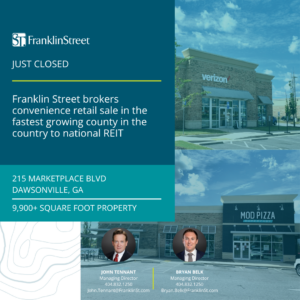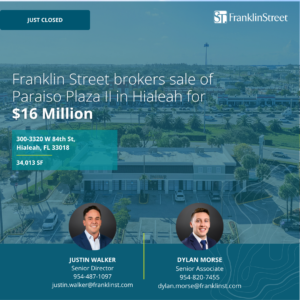Samantha Berk Plate is a Director with Franklin Street Real Estate Services, specializing in retail tenant representation and site selection. Plate, who currently represents tenants that include Dunkin’ Donuts, Smashburger, T-Mobile and Domino’s, discussed current trends in Florida retail and the health of the market.
What kinds of new grocery stores are moving into Florida?
Plate: There has been talk for years of a huge push for the more organic grocers, such as Sprouts, Earthfare, and Lucky’s Market, however, we are just now starting to see some of these units come to fruition. It will be interesting to watch in the next couple of years what type of pace they set, as well as what happens as that sector eventually gets saturated. Aldi continues to expand, driving new mid-size developments. The recent news of Amazon buying Whole Foods will also shape the future of grocers as competition to evolve in a convenience aspect rises.
What kinds of restaurants are expanding here? Examples?
Plate: We’ve seen the large push for the quick service restaurants, more recently with the better burger brands such as Smashburger, as well as Fuzzy’s Taco Shop along the West Coast. As the population has less time, the need for faster turnover has created the demand for quick-serve restaurants, so over the last couple of years that sector has blown up. Non-traditional uses are also popping up in this sector, those catered more so for off-premises consumption. You are seeing some full-service restaurant growth pick up, but are more catered towards casual dining as seen with Texas Roadhouse, Cheddars, etc.
Where do you see most of this growth taking place? Are there any new trends in where new restaurants and grocery stores are popping up?
Plate: Regarding the grocers, the established king, Publix, is doing new developments in high-growth markets where residential has finally picked back up again and stalled community developments are back under way. Trinity is a perfect example of that, with two new Publix stores going in within 1.25 miles of each other, as well as the new Publix locations in Riverview, Ruskin, and Lakewood Ranch. With the new-to-market grocers, they are focusing on already established markets — you’ve seen this with Sprouts in Carrollwood and South Tampa.
Besides the high-growth markets, infill redevelopments in established markets have been a trend for a couple of years now, but it comes at a steep cost. Beyond just the land prices, the development costs have increased greatly as construction costs have climbed. This affects what a developer can pay for land as well as tenant buildouts, and the shortage of skilled trade labor further hurts the cause. All of these factors trickle down into the lease rates for expanding retailers. Most recently, you have seen some restaurants look at more underserved markets. This comes in an effort to attain lower rental rates, and also escape some of the heavy competition from so much restaurant growth elsewhere.
Do you anticipate more growth in Florida’s urban areas, rural/less developed areas or both?
Plate: Florida will experience both, however, urban infill will continue to be more difficult and drive retailers to more rural/residential growth markets.
This is beyond just grocers and restaurants expanding. There is always that one sector expanding, driving up land costs for everyone else. A decade or so ago it was the pharmacies, such as CVS and Walgreens, that led the growth. Then later, the banking industry expanded rapidly. Most recently, it’s been the convenience store sector gaining momentum. What you are seeing is that land costs and development deals are becoming more expensive even though they are not necessarily in the traditional Class A trade areas.
Some of the main users that are driving these developments don’t necessarily need to be in the Class A markets due to their customer base. They are seeking corners in high-density, high-traffic corridors, so we have been seeing increasing prices (and interest in new developments) spread beyond those traditional Class A markets.
What advice do you offer property owners and investors related to Florida retail growth?
Plate: If you can afford holding property, get out in front of it. Follow the growth trends, keep an eye on large master planned developments prior to breaking ground before commercial prices increase as a result of the demand for the new residential.
Potentially look at purchasing centers where some of these struggling big boxes could benefit from value-add improvements as grocers look at those options.



